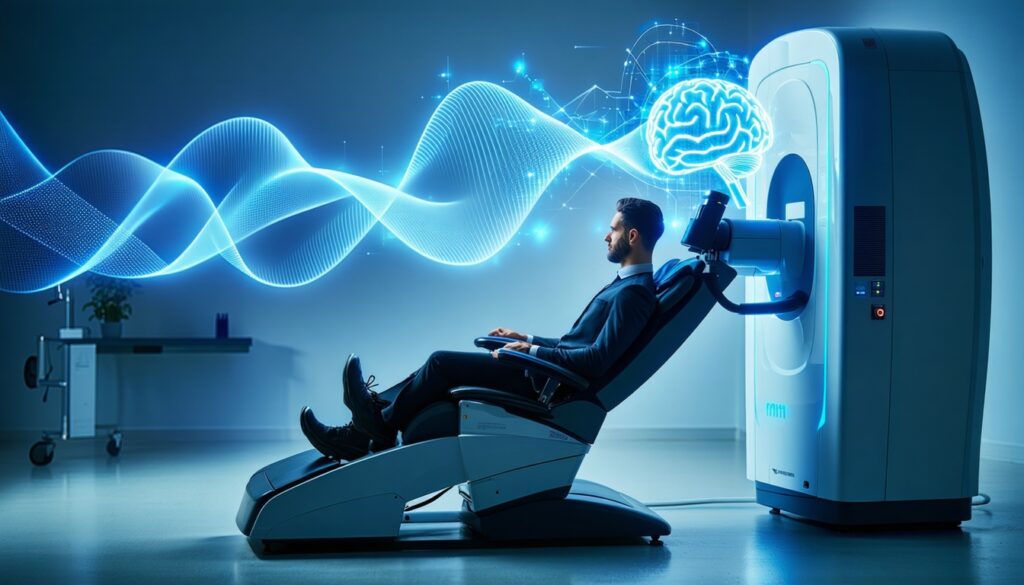Benefits of TMS Therapy
Transcranial magnetic stimulation therapy (TMS) is transforming the treatment landscape for various mental health conditions. Understanding its benefits is crucial for you or a loved one seeking effective options.
Noninvasive Brain Stimulation
One of the standout features of TMS is that it is a noninvasive procedure. This means there is no need for surgery or incisions, making it a safer option for many people. TMS is approved by the U.S. Food and Drug Administration (FDA) to stimulate nerve cells in the brain, effectively helping to alleviate symptoms of major depression, anxiety, and more Mayo Clinic.
| Feature | Benefit |
|---|---|
| Noninvasive | No surgery or cutting of the skin required |
| FDA Approved | Safe and effective for various conditions |
TMS allows you to receive treatment without the risks associated with invasive procedures, providing peace of mind as you explore your mental health options. This approach draws from decades of research, having been introduced in 1985, and has evolved with techniques like high-frequency TMS and intermittent theta burst stimulation, showing promise in effective mental health therapies NCBI.
Approved Conditions for TMS
TMS therapy is not only limited to treating major depressive disorder. It has received FDA approval for a range of conditions, making it a versatile choice for various mental health challenges. Conditions approved for TMS treatment include:
- Major depression
- Obsessive-compulsive disorder (OCD)
- Anxiety
- Post-traumatic stress disorder (PTSD)
- Parkinson’s disease
- Chronic pain
- Nicotine addiction
- Schizophrenia
- Alzheimer’s disease
- Stroke rehabilitation
- Multiple sclerosis
The expanding list of conditions indicates the efficacy of TMS in treating individuals who may not respond to traditional medications or therapies. For instance, it can significantly aid those dealing with TMS for OCD, TMS for PTSD, or TMS for treatment resistant depression.
Choosing TMS therapy with a reputable provider, such as MindHealth MD, will enable you to access top-tier treatment and advance your mental health journey without the need for invasive methods. TMS represents a significant development in mental health care, showcasing how technology can be used to improve lives effectively and non-invasively.
Understanding rTMS and Deep TMS
In the realm of transcranial magnetic stimulation therapy, two notable techniques stand out: repetitive transcranial magnetic stimulation (rTMS) and deep transcranial magnetic stimulation (deep TMS). Both methods aim to harness the power of magnetic pulses to stimulate brain activity, offering new hope for individuals seeking relief from various mental health conditions.
Stimulation Techniques
Repetitive Transcranial Magnetic Stimulation (rTMS) is designed to deliver repeated magnetic pulses to specific brain regions that control mood and are often underactive in individuals experiencing depression. This technique is believed to activate these areas, enhancing brain function over time.
Deep Transcranial Magnetic Stimulation (deep TMS) differs by employing a specially designed coil to reach deeper and wider areas of the brain compared to rTMS. This capability allows deep TMS to engage a broader network of neurons, providing benefits for a range of conditions beyond just mood disorders.
| Technique | Areas Stimulated | FDA-Approved Uses |
|---|---|---|
| rTMS | Specific brain regions related to mood | Major depressive disorder, anxiety, and other mood disorders |
| Deep TMS | Wider and deeper brain areas | OCD, smoking cessation |
Technical applications of these stimulation methods have shown promise in enhancing mood and alleviating symptoms of conditions such as OCD and PTSD.
FDA-Approved Applications
Both rTMS and deep TMS have secured FDA approval for various applications, signifying their effectiveness and safety in treating specific mental health issues.
-
rTMS: This technique is primarily approved for major depressive disorder, offering a valuable alternative to traditional treatments and medications. It is characterized by its ability to improve mood over a series of sessions, gradually enhancing an individual’s quality of life.
-
Deep TMS: This method has gained FDA approval for the treatment of obsessive-compulsive disorder (OCD) and smoking cessation, showcasing its versatility in addressing conditions that may not respond fully to conventional therapies. The broader stimulation area allows for comprehensive intervention, potentially leading to better outcomes in these patient populations.
When considering the options available, it’s essential to consult with a qualified TMS therapy provider who can guide you through your treatment journey and evaluate your specific needs. Whether you or a loved one are looking for an alternative to antidepressants or seeking a non-invasive depression treatment, understanding these advanced techniques is crucial in making informed decisions about your mental health care.
Side Effects and Safety
When considering transcranial magnetic stimulation therapy, it is important to understand both the potential benefits and the side effects associated with the treatment. Here, we detail the common mild side effects and rare serious side effects linked to TMS therapy.
Common Mild Side Effects
Most individuals experience only mild and temporary side effects during TMS therapy. The following are commonly reported:
| Side Effect | Description |
|---|---|
| Headaches | Often mild and resolve shortly after treatment sessions. |
| Scalp Discomfort | Temporary discomfort at the site of stimulation. |
| Hearing Changes | Slight alteration in hearing, often mitigated by earplugs. |
| Lightheadedness | May occur but generally resolves quickly. |
| Fainting | Occasionally happens due to anxiety; recovering from this is usually rapid. |
These side effects are generally manageable and transient [1].
Rare Serious Side Effects
While rare, some serious side effects can occur during TMS therapy:
-
Seizures: This is the most significant concern, with an estimated occurrence of less than 3 patients per 100,000 sessions. Patients with a history of seizures or certain neuropsychiatric conditions are at higher risk. Factors such as lack of sleep or excessive alcohol consumption may also increase this risk [2].
-
Acute Psychological Changes: Some patients might experience exaggerated mood swings or manic episodes, but these instances are extremely uncommon (less than 1% of cases) and usually subside shortly after treatment [2].
Understanding these side effects helps you make informed decisions regarding TMS therapy. If you have further questions or concerns, exploring options at a TMS treatment center can provide tailored insights on whether this therapy is suitable for you.
Treatment Process of TMS
Understanding the treatment process of transcranial magnetic stimulation therapy (TMS) is crucial for those considering this innovative approach to alleviate symptoms of various mental health disorders. Here’s what you can expect during the sessions and the overall duration of this therapy.
Daily Session Details
TMS treatment typically involves daily sessions conducted five times a week. Each session is held in a healthcare provider’s office or clinic, and the duration of each appointment usually lasts between 20 to 40 minutes depending on the specific protocol and individual needs.
The treatment process consists of placing a magnetic coil against your scalp, which delivers magnetic pulses to stimulate nerve cells related to mood regulation. The sessions are noninvasive, allowing you to resume your normal activities immediately afterward.
| Session Frequency | Duration per Session | Total Duration (Weeks) |
|---|---|---|
| 5 Sessions/Week | 20 to 40 Minutes | 4 to 6 |
Based on studies, the effectiveness of TMS treatment often becomes noticeable after a few weeks. If successful, you may experience significant improvement or complete resolution of symptoms, which might include conditions such as treatment-resistant depression, OCD, or PTSD [3].
Duration and Symptom Relief
The total duration of the TMS therapy typically spans 4 to 6 weeks, depending on your individual response to treatment. During this time, you may start to notice an alleviation of your symptoms related to depression or other mental health disorders.
It is essential to remember that some individuals may need ongoing treatments, including additional TMS sessions or other forms of therapy, to maintain these improvements. This integrative approach often enhances the overall effectiveness of the treatment [4].
By considering these aspects of the TMS treatment process, you can better prepare for your journey toward mental wellness. For further insights into what TMS therapy entails, check out our articles on non-invasive depression treatment and drug-free depression treatment.
Insurance Coverage for TMS
Insurance Criteria
When considering transcranial magnetic stimulation therapy, it’s essential to understand the insurance criteria that apply. Typically, medical insurance will cover TMS for conditions like depression, particularly if you have already attempted multiple antidepressants without satisfactory results. According to Mayo Clinic, insurance generally supports repeat treatments if there is a recurrence of symptoms following initial improvement.
Insurers are becoming more receptive to covering TMS as an alternative for patients who have not responded well to conventional treatments, as noted by researchers [5]. However, it is crucial to verify coverage details with both your insurance provider and TMS therapy center before proceeding.
| Condition | Coverage Criteria |
|---|---|
| Depression | Must have tried multiple ineffective medications |
| OCD | Coverage may be limited, but is evolving |
| Smoking Cessation | Varies by insurer; possible emergence of coverage in future |
Coverage Variations
Insurance coverage for TMS can vary significantly depending on the condition being treated. For instance, while many policies cover TMS for depression, coverage for obsessive-compulsive disorder (OCD) treatment may be limited and subject to change as TMS usage increases. As indicated by Mayo Clinic, the availability of coverage is highly context-dependent.
Additionally, in some cases, insurance plans may have specific requirements regarding documentation and previous treatment attempts. Here are some factors that can influence coverage variations:
- Type of Condition: Some conditions, like PTSD or bipolar depression, may have different criteria for coverage.
- Settings: Treatment at an accredited TMS treatment center may affect how coverage is applied.
- Local Policies: Different states may have varying laws governing insurance coverage for mental health treatments.
For personalized assistance with navigating insurance coverage, you may want to reach out to a TMS therapy provider or consult resources that specialize in insurance-related inquiries, such as psychiatrist accepting new patients. They can help ensure you have all necessary information and documentation to maximize your coverage for this innovative non-invasive depression treatment.
Advancements in TMS Research
Research in transcranial magnetic stimulation therapy (TMS) has made significant strides in recent years, expanding its applications and refining treatment protocols. As you explore TMS options, understanding these advancements can provide insight into the efficacy and versatility of this non-invasive treatment.
New Treatment Protocols
Over the last two decades, there has been a considerable increase in the research surrounding various applications of TMS and repetitive TMS (rTMS). This therapy has been extensively studied particularly for treatment-resistant depression, resulting in refined protocols aimed at improving patient outcomes. However, there are emerging interests in applying TMS to other cognitive and psychiatric conditions.
Research is investigating the use of TMS for conditions such as autism spectrum disorder, ADHD, and Tourette’s syndrome, particularly in children. These potential applications come with a need for standardized protocols to maximize effectiveness and minimize risks. Addressing challenges like variability in treatment protocols and biases in clinical trial designs is crucial for further advancements in the field [5].
Device Disparities and Outcomes
The effectiveness of TMS can vary based on the devices used, which underscores the importance of selecting high-quality equipment in treatment settings. Different TMS devices may offer varying characteristics such as pulse frequency, magnetic field strength, and overall design, which may influence treatment outcomes. Here is a comparison of some key device attributes:
| Device Type | Magnetic Field Strength (Tesla) | Pulse Frequency (Hz) | Typical Use Case |
|---|---|---|---|
| Standard TMS | 1.5 to 2.5 | 1-20 | Treatment-resistant depression |
| rTMS | 1.5 to 2.5 | 1-100 | Cognitive enhancement, anxiety |
| Deep TMS | 0.3 to 0.5 | 1-20 | Broad-spectrum psychiatric conditions |
Exploring these device disparities may provide you with insights on how to choose the right TMS therapy provider. It is essential to evaluate the specific technologies and methodologies used at facilities like MindHealth MD to ensure optimal treatment.
As you consider TMS as a treatment option, staying informed about advancements in protocols and device technologies can help you or your loved ones make educated decisions for mental health improvement. For additional information, don’t hesitate to find resources related to TMS therapy and its various applications, including those for PTSD and bipolar depression.








